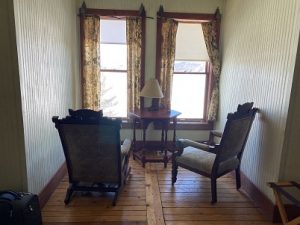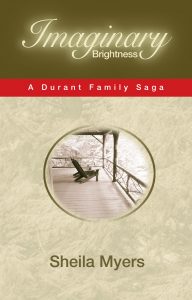From Novel to Screenplay: My Experience
Sheila Myers
 I had this idea that my Durant Family Saga trilogy would get optioned one day as a spin-off of the popular streaming series Hell on Wheels, and I’d make a million dollars.
I had this idea that my Durant Family Saga trilogy would get optioned one day as a spin-off of the popular streaming series Hell on Wheels, and I’d make a million dollars.
That hasn’t happened.
Actually, I didn’t set out writing the Durant Family Saga with the idea it would be adapted to a screenplay. That idea came later while working on my second novel in the trilogy and a fan pointed out that the family patriarch, Doc Durant, was also the main character on the tv series Hell on Wheels. Was it possible?
Serendipity provided me the opportunity to connect with an entertainment executive via a zoom chat who suggested a realistic scenario. “You’re not a best-selling author, and no one is going to come knocking, nor will they pay a screenwriter 25k to write the pilot episode of a series.” So, he said, “Write it yourself.”
I told him I’d give it a try and that my philosophy on writing has always been that if it ever feels like it’s a hardship, or I start to hate the process, I’d quit. He requested I develop a pilot episode and what the industry terms a ‘bible’ for the series. A bible, in a novelist’s world, would be a multiple-page synopsis, laying out each season of the series, the major plot points, and the trajectory of the story. My task was to condense nine hundred pages of my novels to fourteen pages (covering four seasons). We left it that I would send him my script when I was ready.
I took an online class on scriptwriting that I could do at my own pace. I listened to webinars on the craft of writing scripts and bibles. I read everything I could. And I hired a script editor that I found thanks to Lucy V. Hays and her Bang2Write website. It took months but I finally felt confident in sending the draft of my pilot episode (about 45 pages) and the bible for the series. This is what I learned along the way. I hope it helps you if you are thinking of doing this yourself.
1. Purchase software for scriptwriting. I bought Final Draft. It formats everything for you so you don’t have to worry about margins and headers. You will need software made for scriptwriting so you don’t lose your mind over this detail; learning how to write a script is challenging enough.
2. Script readers crave white space. A script consists of Scene Heading (Int. Cabin, Day) Action, and Dialogue. Out the window went all of my pretty descriptions of place which I’m known for in my novels. I read recently in a Twitter thread by a script reader, don’t describe the sunset, we all know what one looks like. That was hard for me. Out of nine hundred pages of my trilogy, I’d guess 1/3 third is descriptive of the Adirondack mountains. Indeed, I’m writing another script based on a short story I published about a millennial being stalked by a mountain lion while snowshoeing. I’m finding it challenging not to detail the majesty of the mountains and the snow glimmering in the sun.
3. It’s all about tense. The action in the script is all present tense. This was pointed out to me by my editor. She waits for him, not She waited for him. Novelists tend to write in past tense so this was a difficult transition for me and takes a keen eye to catch. I got to the point where I searched for ed and ing words to glean where I might need to change tense.
4. POV – pick one. My novels have multiple POVs, hence when I wrote my first draft of the pilot I had multiple POVs. My editor suggested I choose one character to be the lens for the series. He reasoned that it helps the audience engage with the show because they are invested in the character’s journey.
I decided to make Doc Durant’s daughter, Ella, the main POV. I’ve written about her in previous WWWB blog posts and published an essay titled The Other Durant. Her father and brother have biographies written about them, and although she was an author and poet, she didn’t even have a Wikipedia page when I first started writing about the Durant family.
I questioned how to write a script with one POV if Ella is at a London dinner party while her brother William is squandering the Durant fortune clubbing in New York City?
Could I write scenes without Ella in them? I would need to do so to move the plot along. He said, it won’t matter, if done right, the audience will know the arc of the story revolves around Ella and her fate. An example is The Crown series. Queen Elizabeth is not in every scene, yet we know that the people around her and everything they do, every decision they make, impacts HER.
5. Develop your logline. Your logline is your elevator pitch. What is the concept of your pilot? My logline is 1872. Bankrupt railroad tycoon, Doc Durant, summons his family home from London to rebuild their fortunes in the Adirondack Wilderness. For his daughter Ella, it means losing the love of her life and the high society lifestyle she’s grown accustomed to and she’ll do anything to stay. For the adaptation of my short story The Encounter: A Xanax-addled Millennial faces her greatest fears when she’s stalked by a mountain lion while snowshoeing in the woods.
6. Explore the craft, learn about the industry. I sent my final draft of the pilot to my industry connection but I also entered it into a few screenwriting contests through COVERFLY. I figured it can’t hurt to cast the net wide and get some feedback.
The challenge of writing a screenplay allowed me to explore a new craft, new industry and sparked my creativity. It has given me a creative outlet while I wait on the submission and revise and resubmit for two of my novels. It has honed my focus on character development and it has given me a renewed interest in writing for a different type of audience. If you want to see your novel on the screen one day—go for it.
—
Sheila Myers is an award-winning author of four novels. Her last novel in the Durant Family Saga trilogy, The Night is Done, won the 2017 Best Book of Fiction and received a Kirkus-starred review. She speaks about her Durant Family Saga on the History Author Show podcast. Her essays and short stories are published in Embark Magazine, The Stone Canoe Literary Magazine, Crossing Genres, The Adirondack Life Magazine, and History News Network. She is a professor at a small college in Upstate NY. When she’s not planting trees with her students, she’s writing. She can be contacted at her website: https://www.sheilamyers.com/
Imaginary Brightness: a Durant Family Saga
 Who knew the wilderness could be so seductive?
Who knew the wilderness could be so seductive?
“I found myself extremely curious to find out what became of the family and could not put the book down.”
“It’s an historical fiction in which the author adeptly juxtaposes two very interesting tales.”
In this first book of a trilogy, Imaginary Brightness is a Gilded Age drama about the lives of William West Durant and his sister Ella, the children of the powerful American industrialist and railroad tycoon Dr. Thomas C. Durant. William and Ella find their fortunes and reputations threatened by their father’s questionable business dealings as head of the Union Pacific Railroad during the construction of the Transcontinental Line.
As the family’s finances teeter on the brink of bankruptcy, both brother and sister are whisked from their privileged lifestyle in high society London to the untamed Adirondack forests.
It is in this wilderness landscape that the tension between passion and propriety, their future and their family, turn their worlds upside down. Imaginary Brightness explores the early conquest of the great north woods, eavesdrops on America’s robber barons from the supper clubs of Manhattan, and reveals the inner turmoil of a dynastic American family.
BOOKBUB DEAL! https://www.bookbub.com/books/imaginary-brightness-by-sheila-myers
Category: How To and Tips
























Thanks for this article. Your book looks fascinating, and your script-writing journey was great to read. I have just started my own journey in the script-writing arena for my latest novel, and it was really nice to read about yours.
Good luck with your creative endeavors, Claudia!
Thanks Claudia – good luck with your screenplay. If you need a reader let me know.